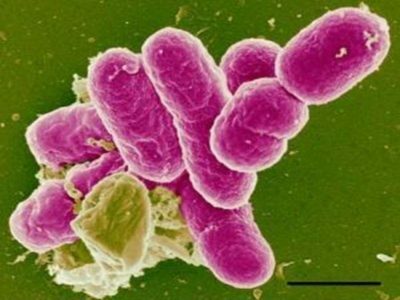1 Dysentery disease
Dysentery is caused by a bacterium like Shigella. It is considered to be stationary and has a rod-like shape. Its dimensions reach only 3 μm. It does not form spores, so it does not have environmental resilience. Despite this, some of its varieties can for a long time be viable in dairy products and water.
Do you have gastritis?
GALINA SAVINA: "How easy is it to cure gastritis at home for 1 month. Tested method - write down the recipe. ..!"Read more & gt; & gt;

It is recommended to read
- Signs of dysentery in an adult
- Symptoms and diagnosis of dysentery
- Symptoms and treatment of leptospirosis in humans
- Effective agent for gastritis and gastric ulcer
Shigella conditionally divided into groups, and those are divided into serovars( there are about 50).Differences between these categories are in the habitat, synthesized enzymes and the properties of toxic compounds.
Shigella can withstand the effects of a number of antibiotics, so antibacterial therapy does not always give a positive result.
When boiling shigella instantly die. If the heating temperature is only 60 ° C, then the bacterium can live in such conditions for 10-15 minutes.
The bacterium can survive under the influence of ultraviolet radiation. It is resistant to acids, so that the gastric juice does not neutralize it.
The bacterium can penetrate into the cellular structure of the mucosa of the thick intestine. It multiplies within the epithelial cell structures that line the inner side of the intestine.
The shigellosis bacterium synthesizes and releases toxic compounds. Endotoxins are isolated only after the bacterium is destroyed. This substance provokes the appearance of malfunctions in the intestine and affects the cellular structures of the organ. In addition, it passes into the blood, poison the blood vessels and the nervous system. Exotoxins are released when the bacterium is still alive. These compounds disrupt the integrity of the membranes of the intestinal cellular structures. Enterotoxins cause increased release of salts and water into the intestinal lumen. Because of this, diarrhea appears. Neurotoxins poison directly the nervous system. Because of this, there are weakness, fever, headaches.
During infection with shigella, the balance between bacteria in the lumen of the intestine is disturbed. This kind of microorganisms can oppress normal microflora and develop pathogenic. This provokes intestinal dysbiosis.
-
 IMPORTANT TO KNOW! Gastritis? Ulcer? To prevent a stomach ulcer from becoming cancer, drink a glass. ..Read the article & gt; & gt;
IMPORTANT TO KNOW! Gastritis? Ulcer? To prevent a stomach ulcer from becoming cancer, drink a glass. ..Read the article & gt; & gt;
2 Methods of infection with shigella
This bacterial organism can be transmitted in the following cases:
- From a patient, with both acute and chronic forms of the disease. And the most dangerous are those patients who have an easy form of ailment, because they have a weak disease, and they may not even know about their problems with the intestines.
- From the convalescent. This is a person who is already recovering, but has not passed a fortnight since the beginning of the disease.
- From the carrier. This is the person who spreads shigella to the environment, but he himself is not sick, because the symptoms of the disease do not manifest.

The mechanism of transmission of the causative agent of the disease is fecal-oral. The bacterium is released together with the calves. Then it gets into the body of another person, if he did not wash his hands or drank dirty water, or ate food that had previously been contaminated. People have a rather high susceptibility to shigellosis, if they are infected. However, according to statistics, 75% of patients only have an acute form of the disease.
Shigella transfer method happens:
- food;
- water;
- household.
With the food method, the bacterium enters the foodstuffs through the hands of other people. Also, it can be on the surface of the food, if it was washed with dirty water. The bacterium can be carried with flies. Another option for getting on vegetables is adding to the soil, where berries and vegetables of organic fertilizers are growing. Human feces may also fall into the soil. The most dangerous when infected with shigella are vegetables, berries and dairy products, as they are considered to be the optimal medium for the pest. The food method of infection is the most common. Most often this applies to Shigella Flexner.
-
 Gastroenterologist. VAZHENOV: "I beg you, if you began to worry about abdominal pain, heartburn, nausea, do not in any way do gases. .."Read more & gt; & gt;
Gastroenterologist. VAZHENOV: "I beg you, if you began to worry about abdominal pain, heartburn, nausea, do not in any way do gases. .."Read more & gt; & gt;

The bacterium can get into the water together with human feces and drains, as well as during the washing of things. In addition, a frequent option is an accident at the water purification facilities. Still dangerous are natural reservoirs of large and small sizes, various wells, basins. In countries with a low level of quality of life, tap water also presents a danger. Do not use it, use it to wash dishes and swim, so as not to get infected with shigella. By the way, with the water type of infection there is an epidemic, because a large number of people are infected simultaneously. Usually this applies to the warm seasons of the year. An aquatic variant of infection is more characteristic of dysentery Sonne.
The household variant is more typical for shigella Shigi-Grigoriev. The bacterium enters the human body if it does not follow the rules of hygiene. For example, particles of contaminated feces could get on household items, and from there already go to the mucous membranes of the oral cavity. Usually this applies to bed linen, towels and children's toys.
TIP FROM THE MAIN GASTROENTEROLOGIST
Korotov SV: "I can recommend only one remedy for the rapid treatment of Ulcer and Gastritis, which is now recommended by the Ministry of Health. .." Read the reviews & gt; & gt;
When homosexual intercourse also has a high risk of infection.
3 Symptoms of shigellosis
If a person develops shigellosis, the symptoms will appear gradually depending on the stage of the ailment. In the first stage shigella passes from the oral cavity to the stomach. Then descends into the intestine and there is fixed on the walls. Here gradually the bacteria multiply and release toxic compounds, which leads to general intoxication of the body.
In the second stage, the number of shigellas increases. They spread to the lower part of the large intestine. Further they penetrate into the epithelial structures. Now they can isolate mucin - this is a special enzyme that dissolves the membranes of cellular structures. Because of this connection between the cells and they themselves are destroyed. This leads in the future to ulcerative colitis.
The incubation period lasts from 1 day to a week. Usually only 2-3 days is enough. Next, the first symptoms appear:
- Body temperature rises. Usually it reaches 36-39 ° C.This is the reaction of the immune system to the appearance of toxins in the blood, which synthesize microorganisms. Because of this, fever and chills are felt. The patient begins to fever.
- Then there is a general intoxication of the body. It concerns weakness, sensation of aches in the body, apathy, headaches, dizziness, worsening of appetite.
- The chair gets thicker, it becomes too liquid. There are mucous and bloody veins. Usually a person suffers from diarrhea 2-3 days. Acts of defecation are rather painful. Drugs for diarrhea do not help badly, since they do not affect the amount of bacteria in the intestine.
- Then there are pain in the abdomen. This is due to the fact that the bacterium is introduced into the intestinal mucosa and begins to destroy these tissues. Appears nausea and vomiting attacks. Sometimes blood pressure decreases, tachycardia arises.
What is shigellosis, every person should know, since no one is immune from this intestinal problem. It is better to prevent the appearance of this disease than to devote it to treatment for a long time.
- 1 Dysentery disease
- 2 Methods of infection with shigella
- 3 Symptoms of shigellosis
Shigellosis is an acute form of an intestinal disease that is caused by an infection that affects the mucous membranes of the thick intestine. This disease is also called bacterial dysentery. The person has a stomach ache, the stool becomes liquid, sometimes with blood clots. In addition, all symptoms of intoxication will be noticeable. This ailment causes a bacterium from the shigella genus, which is transmitted through the fecal-oral pathway.



